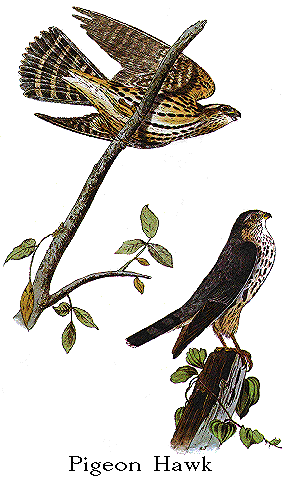
| Family II. FALCONINAE. FALCONINE BIRDS.
GENUS IX. FALCO, Linn. FALCON. |
Next >> |

Family |
PIGEON HAWK. [Merlin.] |
| Genus | FALCO COLUMBARIUS, Linn. [Falco columbarius.] |
The Pigeon Hawk ranges very extensively over the United States, and extends
its migrations far beyond their limits on either side. Mr. TOWNSEND found it on
the Rocky Mountains, as well as along the shores of the Columbia river. Dr.
RICHARDSON mentions it as not uncommon about York Factory, in latitude 57
degrees, and it is not improbable that it wanders farther, as he speaks of
having seen a small Hawk on the north shore of Great Bear Lake, in latitude 66
degrees, which may have been a male as small as the one represented in my plate.
I found it very abundant in the Texas early in May, when I shot as many as five
on a small island in a short time.
Mr. HUTCHINS's description of the eggs of this bird, which he says are
white, and from two to four in number, as well as the situation of its nest, as
given in his Notes on the Hudson's Bay Birds, is greatly at variance with my own
observations. The eggs in these instances, which occurred at Labrador, were
five; they measured an inch and three-quarters in length, an inch and a quarter
in breadth, and were rather elongated; their ground colour a dull
yellowish-brown, thickly clouded with irregular blotches of dull dark
reddish-brown. In that country they are laid about the first of June. In the
beginning of July I found five in a nest that were ready to be hatched. The
nests were placed on the top branches of the low firs peculiar to that country,
about ten or twelve feet from the ground, and were composed of sticks, slightly
lined with moss and a few feathers. At this season the old birds evinced great
concern respecting their eggs or young, remaining about them, and shewing all
the tokens of anger and vexation which other courageous species exhibit on
similar occasions. The young are at first covered with yellowish down; but I
had no opportunity of watching their progress, as all that were taken on board
the Ripley died in a few days. This species also breeds in Nova Scotia and New
Brunswick.
A male from the Texas. Length to end of tail 13 1/4 inches, to end of
wings 11 5/12, to end of claws 11 6/12; extent of wings 26.
The mouth resembles that of the other Falcons; its breadth (9 1/2) /12ths.
The tongue is short, 6/12ths long, fleshy, deeply emarginate and papillate at
the base, broadly grooved above, the tip rounded and slightly emarginate. The
oesophagus is 4 1/2 inches long, its width at the upper part half an inch. The
stomach is very large, round, 1 1/2 inches in diameter, with a very thin
muscular coat; its central tendons 4/12ths in diameter. The proventriculus is
9/12ths long; its glands very numerous, and cylindrical. The intestine is 26
3/4 inches long, (2 1/2) /12ths in its greatest diameter. There are merely two
slight indications of coeca; and the cloaca is globular, with a diameter of 1
inch.
The trachea is 2 3/4 inches long, a little flattened; the rings 58, well
ossified; its breadth at the upper part 3/12ths, at the lower 2/12ths. The
contractor muscles cover the anterior surface entirely in the upper third, and
are of moderate strength, as are the sterno-tracheales; a pair of inferior
laryngeal muscles going to the membrane between the last tracheal and first
bronchial half ring. The bronchial half rings are 15 and 18.
PIGEON HAWK, Falco columbarius, Wils. Amer. Orn., vol. ii. p. 107.
FALCO COLUMBARIUS, Bonap. Syn., p. 38.
PIGEON HAWK, Falco columbarius, Nutt. Man., vol. i. p. 60.
LITTLE CORPORAL HAWK, Falco temerarius, Nutt. Man., vol. i. p. 61. Adult Male.
FALCO COLUMBARIUS, Pigeon Hawk, Swains. and Rich. F. Bor. Amer., vol. ii. p. 35.
FALCO AESALON, Merlin, Swains. and Rich. F. Bor. Amer., vol. ii. p. 37.
PIGEON HAWK, Falco columbarius, Aud. Orn. Biog., vol. i. p. 466; Young,
vol. i. p. 381; Male, vol. v. p. 368.
Wings from two to three inches shorter than the tail, on the middle
feathers of which are five, on the lateral six, broad whitish bands. Adult male
with the cere greenish-yellow, the feet pale orange, the upper parts light
bluish-grey, each feather with a black central line; lower parts reddish or
yellowish-white, the breast and sides with large oblong brown spots; tibial
feathers light red, streaked with blackish-brown. Female with the cere and legs
greenish-yellow, the upper parts dark greyish-brown, the lower pale red, spotted
as in the male. Young with the head light reddish-brown, streaked with dusky,
the upper parts brownish-grey, the feathers margined and spotted with pale red,
throat white, lower parts pale red, streaked with brown. The tail-bands vary
from pale red to white.
| Next >> |